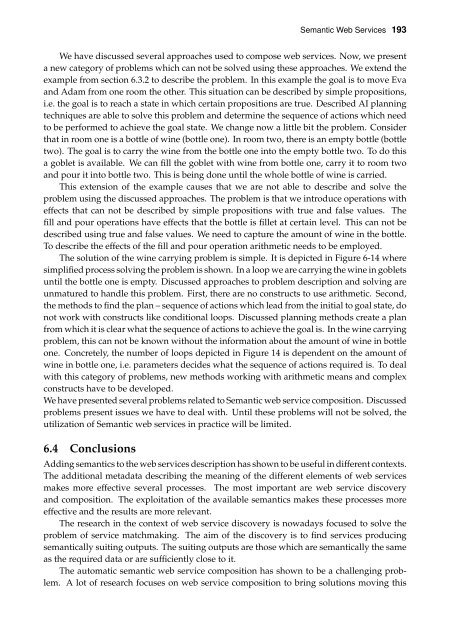elektronická verzia publikácie - FIIT STU - Slovenská technická ...
elektronická verzia publikácie - FIIT STU - Slovenská technická ...
elektronická verzia publikácie - FIIT STU - Slovenská technická ...
You also want an ePaper? Increase the reach of your titles
YUMPU automatically turns print PDFs into web optimized ePapers that Google loves.
Semantic Web Services 193<br />
We have discussed several approaches used to compose web services. Now, we present<br />
a new category of problems which can not be solved using these approaches. We extend the<br />
example from section 6.3.2 to describe the problem. In this example the goal is to move Eva<br />
and Adam from one room the other. This situation can be described by simple propositions,<br />
i.e. the goal is to reach a state in which certain propositions are true. Described AI planning<br />
techniques are able to solve this problem and determine the sequence of actions which need<br />
to be performed to achieve the goal state. We change now a little bit the problem. Consider<br />
that in room one is a bottle of wine (bottle one). In room two, there is an empty bottle (bottle<br />
two). The goal is to carry the wine from the bottle one into the empty bottle two. To do this<br />
a goblet is available. We can fill the goblet with wine from bottle one, carry it to room two<br />
and pour it into bottle two. This is being done until the whole bottle of wine is carried.<br />
This extension of the example causes that we are not able to describe and solve the<br />
problem using the discussed approaches. The problem is that we introduce operations with<br />
effects that can not be described by simple propositions with true and false values. The<br />
fill and pour operations have effects that the bottle is fillet at certain level. This can not be<br />
described using true and false values. We need to capture the amount of wine in the bottle.<br />
To describe the effects of the fill and pour operation arithmetic needs to be employed.<br />
The solution of the wine carrying problem is simple. It is depicted in Figure 6-14 where<br />
simplified process solving the problem is shown. In a loop we are carrying the wine in goblets<br />
until the bottle one is empty. Discussed approaches to problem description and solving are<br />
unmatured to handle this problem. First, there are no constructs to use arithmetic. Second,<br />
the methods to find the plan – sequence of actions which lead from the initial to goal state, do<br />
not work with constructs like conditional loops. Discussed planning methods create a plan<br />
from which it is clear what the sequence of actions to achieve the goal is. In the wine carrying<br />
problem, this can not be known without the information about the amount of wine in bottle<br />
one. Concretely, the number of loops depicted in Figure 14 is dependent on the amount of<br />
wine in bottle one, i.e. parameters decides what the sequence of actions required is. To deal<br />
with this category of problems, new methods working with arithmetic means and complex<br />
constructs have to be developed.<br />
We have presented several problems related to Semantic web service composition. Discussed<br />
problems present issues we have to deal with. Until these problems will not be solved, the<br />
utilization of Semantic web services in practice will be limited.<br />
6.4 Conclusions<br />
Adding semantics to the web services description has shown to be useful in different contexts.<br />
The additional metadata describing the meaning of the different elements of web services<br />
makes more effective several processes. The most important are web service discovery<br />
and composition. The exploitation of the available semantics makes these processes more<br />
effective and the results are more relevant.<br />
The research in the context of web service discovery is nowadays focused to solve the<br />
problem of service matchmaking. The aim of the discovery is to find services producing<br />
semantically suiting outputs. The suiting outputs are those which are semantically the same<br />
as the required data or are sufficiently close to it.<br />
The automatic semantic web service composition has shown to be a challenging problem.<br />
A lot of research focuses on web service composition to bring solutions moving this

















